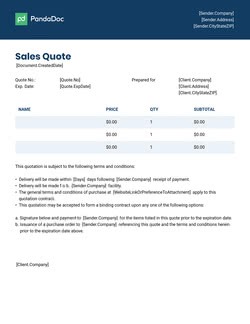Knowing how to write a quote for a job is essential when closing a deal after putting in time and effort generating leads for your company.
Whether it be a business quote, or a sales quotation, a professional quote is a vital document that the price options a seller proposes to a potential client.
A business quote serves as a contract and usually uses a more formal tone.
We’ve all heard the saying ‘first impressions count’.
Well, that could not be more true when writing a quote for a job.
A quote in business is a reflection of your company brand and the way you work, and so it is crucial to write a professional quotation that is accurate, value for money and attentive to the needs of the customer.
The final pricing of any new quote document may include additional cost details such as the taxes, labor, raw material total costs, and other factors.
A business quote also includes:
- The duration for which it is valid
- The expected duration of service completion
- The goods delivery
This article will talk you through the meaning of a professional quotation, why writing a strong business quote makes all the difference to your company, how to write a quote for a job, how to send a quote to your clients, and examples of templates will help your business win those deals.
What is a quotation or a quote in business?
The meaning of a quote in business is an agreement between a consumer and a service business to offer a service at a pre-determined price and within a specific time frame.
This covers a pricing quote, service quote, sales quote, or any other type of quote.
A quotation is designed to fit both client needs and the business owners providing the service required.
The quote depicts a breakdown of the numerous costs that are combined together to get the final, total cost of a job.
Once a quote has been agreed upon between the service provider and the consumer, it cannot be changed unless both parties agree in writing.
Lawn care, landscaping, HVAC, cleaning, and general contracting estimates differ from quotes for items.
Comparing services is frequently more complex than comparing products because total costs differ from one company to another.
A business quote is frequently the first impression clients make of your company name; therefore, a quotation is an important step toward getting a contract.
That’s why putting together a professional quote that explains the value of what you’re charging for is critical to landing more (and bigger) jobs.
How important is a quotation in business?
As prices for commodities are often fixed, you may wonder why there is a need for business quotes at all. Well, with fixed prices, businesses usually create an invoice to deliver the information.
However, in cases where the prices vary or depend on certain conditions, service quotes are generated before the order is confirmed. Essentially, quotes serve a similar, but not the same, purpose as an invoice.
Being sent before the invoice, business quotes shape the first point of business contact with the client. A well-prepared quote can help turn a prospective client into a real customer.
In that sense, business quotes need to meet certain standards as they add substantial value to the future relationship with the client.
In today’s competitive market, small businesses and large companies alike target the same cohort of audiences, making competition fiercer.
“It’s time to stop manual data entry, so you can focus on crushing your quota.”
PandaDoc
Nowadays, there’s no time to dwell on things; instead, the moment an opportunity presents itself, you react.
Immediately upon receiving a request for a quote, start drafting it according to your brand guidelines and your customer’s requirements.
The best way to start drafting a business quote is to research the customer’s requirements.
To win them over, always use the client’s RFQ for more details, and take their demands into consideration.
You can also rely on your previous, successful quotes for inspiration.
How to write a professional quote for a job that attracts customers in 8 easy steps?
In today’s competitive market, small businesses and large companies alike target the same cohort of audiences, making competition fiercer.
“It’s time to stop manual data entry, so you can focus on crushing your quota.”
PandaDoc

NowaTodays, there’s no time to dwell on things; instead, the moment an opportunity presents itself, you react.
Immediately upon receiving a request for a quote, start drafting it according to your brand guidelines and your customer’s requirements.
The best way to start of drafting a business quote is to research the customer’s requirements.
To win them over, always use the client’s RFQ for more details, and take their demands into consideration.
You can also rely on your previous, successful quotes for inspiration.
The objective of a business quote is to motivate your customers to choose your offer over others and seal the deal.
The following eight comprehensive steps can help you craft the perfect quote for a job and land the business you are aiming for.
1. Choose a professional quote template
One of the first stages in establishing trust with your clients when writing a quote for a job is to create a professional quote layout and design.
Your clientele will notice that you’re running a professional firm if you use a digital, easily replicable template.
At the top of the page, your quote template should have your company name and/or logo, which should be left-aligned.
Example of a professional quote for a job using a template
It would help if you also put the term “quote” upfront at the top of your page so that it’s clear what the paper is about right away.
2. Enter your quote number
A quotation number is a unique, sequential number you assign to each of the quotes you send to clients, similar to an invoice number.
Quote numbers make it simple to keep track of and arrange your quotes in your CRM.
Your quotation number should be prominently displayed at the top of your estimate for easy identification.
Here are a few other things you should be aware of:
- Quotes can be alphanumeric, which means they can contain both letters and digits (no special characters or symbols).
- Depending on how you structure your quotes, they are usually between 3-5 numbers long.
- Add a client’s name or initials if desired.
3. Add customer information
Customer details are a must of every business quotation. Fill out the quote with your customer’s details to enable easier follow-up.
This part of your quotation for a job contains information such as their name and address.
You can also provide their phone number or email address.
4. Add product or service descriptions
As line items, list the products and/or services you’re offering in your professional business quote. Include a description of the items and their quantities, product numbers, unit prices, and total prices (if applicable).
You can also categorize the products and services based on the stage of the project.
You might want to keep labor and material prices and payment terms separate.
This task can be made simpler by using a quotation template tailored to your industry to structure your cost breakdown.
Quotation example
PandaDoc offers a variety of sample quotations in various formats, allowing you to pick the one that best suits your needs.
To find the best quotation format for you, go through our template gallery.
5. Add your business and contact information
Make your contact information clear, accurate, and easy to find on your quote for a job. If your client has any questions, they should be able to get your contact information quickly.
This information should include your:
- Business name and logo
- Address
- Phone number
- Email address
- Fax number, if applicable
6. Include the issue date
The day you sent your business quotation to the client is the date of issue. This is crucial since it will prove when the quote was sent.
A deadline for how long the quote for a job is valid should also be included. Supplier prices, seasonal demand, and staff availability all change over time, and so do your prices.
Ensure the professional quote has an expiry date to ensure an accurate and profitable price.
It takes 14 to 30 days on average, with 30 days being the most typical timeframe.
7. Specify the terms and conditions of your business quote
This is where you spell out your and your customer’s responsibilities. Without terms and conditions, a quote for a job is incomplete.
A precise estimate disclaimer helps you avoid client disagreements and establishes expectations from the beginning.
The following are examples of quote terms and conditions:
Term of payment
This can contain things like a deposit that needs to be paid up in advance, different payment methods you accept (check or credit card), a time period you anticipate to be paid.
Costs of additional work
If the project requires any further work, you can safeguard your company from not being paid by putting additional work fees in your terms and conditions.
A contractor may, for example, charge for some deliverables, but not for others.
For instance, they’ll have a fixed price for the labor required to install kitchen cabinets but not for the cost of picking up the cabinets from the store (which the homeowner can choose to do instead).
Changes to the project that were not anticipated
This is especially crucial for firms that operate outdoors and rely on favorable weather to complete their tasks.
To find your subtotal, add up all of the expenditures. Then, if applicable, add the tax to get the total.
8. Include notes and/or additional details
After you’ve added the necessary information, make any additional comments, such as:
- Any potential price reduction (i.e. if you are applying a seasonal or referral discount)
- A section for signatures
- Purchase order number (from the client)
- A discount (if any)
- A note expressing gratitude for their collaboration
Aim to send a quote for a job as soon as possible or as soon as the client contacts you to request one — ideally, within 24 hours of the initial contact.
Also, always double-check that everything is right before sending your business quote.
This includes correcting any price errors or misspellings so that your quotes reflect your professionalism.
How to send a quote to your client by text or email
Sending a quote for a job to your client by text or email is a common and efficient way to provide pricing and details for your products or services.
Remember that in both cases, professionalism and clarity are key. Ensure that your quote is well-structured and easy for the client to understand, and be responsive to any inquiries or feedback they may have. Follow our step-by-step guide on how to do it.
Sending a job quote by email
Prepare the quote
Create a detailed job quote that includes the scope of work, pricing, terms, and any other relevant information.
Compose an email
Start a new email in your preferred email client. In the “To” field, enter the client’s email address. In the “Subject” line, include a clear and descriptive title, such as “Job Quote for [Client’s Name].”
Introduction
Begin the email with a professional and friendly greeting. Briefly explain the purpose of the email, such as “I am pleased to provide you with a quote for the [specific job or project].”
Attach the quote
Attach the job quote document you created in step 1 to the email. Ensure it’s in a format that can be easily opened and read by the recipient (e.g., PDF or Word document).
Provide details
In the body of the email, offer a summary or overview of the quote, highlighting key points, important terms, and any special instructions or conditions.
Express interest
Express your continued interest in the job and your availability to answer any questions or discuss the quote further.
Closing
Use a polite and professional closing, such as “Sincerely” or “Best regards.”
Signature
Include your name, title, contact information, and any relevant links to your website or social media profiles.
Proofread
Before sending, thoroughly review the email and attached job quote document for accuracy, clarity, and completeness.
Send the email
Click the “Send” button to deliver the email and the attached job quote to your client.
Sending a quote for a job by text message:
Sending a job quote via text is more condensed due to character limitations, but here’s how you can do it:
Prepare the quote
Create a concise and well-formatted job quote that includes the essential details.
Open your messaging app
Launch your text messaging app on your mobile device.
Select the recipient
Choose the client’s contact from your phone’s address book.
Compose the message
Start by addressing the client by name or with a polite greeting, e.g., “Hi [Client’s Name].” Present the job quote in a clear and concise manner, including the scope of work, pricing, and any crucial terms. Ensure the message is easy to read and understand within the character limit.
Request confirmation or questions
Encourage the client to confirm receipt or ask any questions by saying something like, “Please let me know if you have any questions or if you’d like to proceed.”
Signature
Sign the text with your name and a brief contact detail, such as a phone number.
Send the message
Tap the “Send” button to deliver the job quote via text.
Follow-up
After sending the job quote, you may want to follow up with an email containing a more detailed quote or additional information if needed.
How to request a quote?
If a small firm has to employ a subcontractor or specialist for work outside of their expertise, they may obtain a bid. They can submit a “request for quote letter” to one or more vendors, who will respond with price estimates.
A letter requesting a quote should be precise and concise and include the date by which you need the price.
Include the number of items you want to order. Indicate the services you’re interested in when it comes to services.
Sample quote request
Subject: Quotation Request
Dear [Name],
My name is [Name] and I am a Manager from [Your Company Name]. I am writing to request a quote on the following services:
[Put the list of services here]
Please confirm the availability and send us a detailed description of the services and their pricing. I expect a response by the 12th of February.
Thank you for your time. I look forward to hearing from you.
Please, feel free to call or email us for further clarification.
Sincerely,
[Name]
[Title]
How do you decline a quote?
Received a pricing quote that you don’t like? Perhaps the price was too high, or you chose to work with a different firm?
That’s all okay, but, since the company took the effort to generate the quote, you need to let them know of your decision.
Thank them for their proposal and explain why you are unable to accept their offer.
Sample quote rejection
Dear [Name]
Thank you very much for a detailed quote for [name goods or services], which I received [date].
I very much regret that we will not be able to place an order with you as, at this time, [put your reason here]. For this current order, we have made a decision to cooperate with other vendors.
Should we need a quote for any other goods/services you offer in the future, we will of course be in touch.
Yours Sincerely,
[Name]
[Title]
Checkpoints before you hit the send button on your quote for a job
A superior business quote will help conversions turn into invoices.
To ensure success, here are a few crucial checkpoints to go through before sending your professional quote.
Double-check the calculation
The main intention of any business quotation is to provide accurate and relevant pricing information. Recheck all your numbers before you send a quote to the prospective client.
A wrong calculation may not only mislead the prospect but also read unprofessional.
Stay on top of your formatting
Proper formatting ensures your quote for a job is laid out correctly in terms of appearance. Choose clear fonts, highlight headings, and keywords, and choose soothing colors (if required).
This will make your business quote easy to read and presentable.
Cross-check spelling and grammar
Your business quotation must be accurate. Complicated language or a tiny spelling or grammatical error can confuse the client and leave a wrong impression, reducing your chances of deal closure.
To avoid mistakes and errors, review the final quotation before sending it.
Notes for clarity
If certain information in the terms and conditions or your pricing structure is a bit complex, you can include a disclaimer and/or add small notes for clarity.
These notes should provide additional info to help your potential client decide.
Optional details
A business quotation is typically a concise document. However, you can include some extra information like other services you offer, discounts, time frames you usually take to complete tasks, etc.
These optional details could be a stepping stone into persuading a prospective client to choose you.
How to write a quote for a job that wins more business
Although it may appear a small part of the business process, writing attractive business quotations is essential in seeking and retaining potential customers.
To win the deal, it is imperative to create accurate and concise quotations that meet customers’ requirements while fitting a professional layout.
Therefore, automation and investing in good accounting software may be a good idea for your business name and reputation on the market.
PandaDoc software is a good bet as it provides a library of over 750+ quote templates designed to help you create your quotations for jobs professionally and efficiently, and make a lasting impression on your clients.

Sales Quote Template
Used 6766 times
Use this free Sales Quote template to let your prospective client know how you can help them, as well as how much it may cost them.
Use this templateFrequently asked questions
-
There are several kinds of professional quotes. These include service quotes, pricing quotes, sales quotes, etc. Professional quotes are mainly there to inform clients how much a company’s services would cost and the required time those services would take to execute.
-
You can write an official quote by mentioning the services you offer, their cost, terms and conditions of agreement, contact information of all parties, etc. Many businesses usually use RFQ templates to produce official quotes, which you can borrow here.
-
A quote is usually confused with a proposal. While these documents can be used for the same purposes, they still differ in several aspects.
Job quotes primarily focus on providing a cost estimate for a specific job, are often legally binding, and are more concise. Proposals, on the other hand, are comprehensive documents that include not only pricing but also detailed solutions, are generally not legally binding, and are designed to persuade clients to choose your business for a project.
The choice between a job quote and a proposal depends on the specific needs and expectations of the client and the nature of the business relationship.
-
A quote is a document sent to a potential buyer before the work is done. The document informs them of the price they’ll pay for the selected goods and services provided.
An invoice is a financial document that requests payment when work has been finished or a pre-determined progress milestone has been met. An invoice also shows the dates when a set of services or a product was finished, as well as the exact amount owed by your client for each line item and the total amount owed for all items.
-
PandaDoc is a great place to start. The PandaDoc template library offers +1000 templates that will jumpstart your document creation time savings and give your customers the ultimate doc experience. Discover the perfect business proposal template and customize it to suit your needs.
-
You can inspire a business owner by touching on all the necessary checkpoints, such as grammar, calculation, clarity, formatting, etc. in your quote. Adding automation to your business is another trick through which you impress business owners, as it allows you to streamline processes.
Disclaimer
PandDoc is not a law firm, or a substitute for an attorney or law firm. This page is not intended to and does not provide legal advice. Should you have legal questions on the validity of e-signatures or digital signatures and the enforceability thereof, please consult with an attorney or law firm. Use of PandaDocs services are governed by our Terms of Use and Privacy Policy.
Originally published May 3, 2017, updated December 1, 2023


